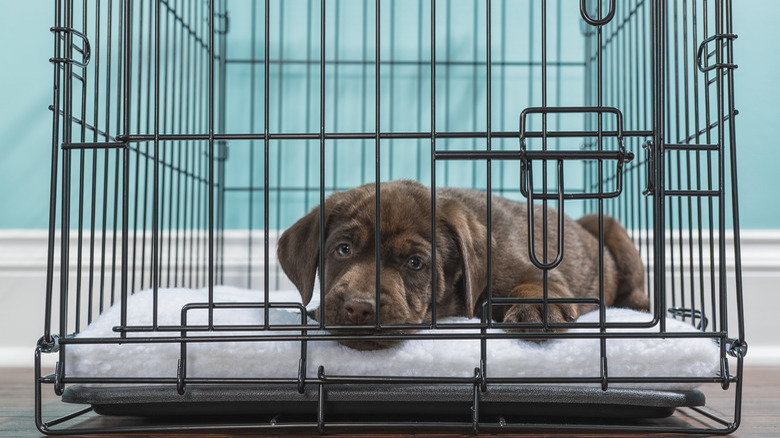How Can I Make A Dog Crate Smaller?
Unless you have a workshop with a variety of tools that can cut metal, wood, and plastic and glue, nail, or weld them back together, you'll be hard-pressed to reduce the overall size of a dog crate. That doesn't mean you can't make the crate "smaller" to better control your pet when it's inside. Using a bit of creativity, safe materials, and taking care to avoid sharp edges or other hazards, you can change the interior size of a dog crate to make it more appropriate for your dog.
Why change the size?
A dog crate should be large enough for the pet to stand up and turn around, especially if the dog will be spending many hours in it. A crate that is the right size for a puppy will eventually become too small, requiring you to buy a new one, cramping your dog until you do.
If you try to save money by buying a larger crate your dog will eventually grow into, it might encourage the puppy to relieve itself in the back part of the crate it's not using. This obviously interferes with your attempts to house break a dog using crate training. Some crates come with a large dog crate divider you can use to expand the area for your dog as your puppy grows, points out DogTime.com.
Check out the return policy
Before you begin making any modifications to a dog crate, check the store return policy or warranty. If you're planning on making a change to the container that involves cutting or drilling a hole or gluing, you know you won't be able to return it.
After reviewing your store's return policy or the manufacturer warranty, you might decide you want to return the crate and get a smaller one for your dog. The place where you bought the crate (online or at a brick-and-mortar store) might have a good exchange policy that lets you trade one crate for another with less hassle than a return and new purchase.
Reduce the interior space
The easiest way to a make a dog crate "smaller" is to decrease the interior space available to the dog by inserting some sort of filler. If your goal is to make the cage less tall, you can insert some type of flooring, such as a non-porous material, and then cover it with a towel, blanket, or bedding.
This leaves the crate with the same interior length, but makes the ceiling lower, which you might want to do if your dog is jumping in the crate. If you do this, make sure the material you choose will repel, not absorb, any dog waste that makes it through the towel, blanket, or bedding. The material should also be non-toxic in case the dog pushes the covering you've put on it aside.
You can try another method of reducing the interior space of the crate by placing material in the back of crate. Use enough to create the desired remaining space in the crate for the pet. If you don't want to use glue or screws in the crate to attach your filler item or material, you can try tying it in. Wrap string or other material around the item you've put in the crate, then extend it out of the crate's holes or wire openings and run it through the sides and back of the crate, tying it off at the back.
Be very careful that you are able to hide this string or wire from the dog on the inside so that it does not cut or choke itself on the line. You can do this by stapling the line to the material you're using as filler, or place padding, such as a blanket, over the material in a way the dog can't get past.
You don't have to use filler material to reduce the interior of the crate. An alternative would be to insert a crate divider panel. If you use another grate or material your pet can see or pee through, this might lead to your dog trying to get into that side of the crate, becoming frustrated, and whining when it can't. If your crate divider panel isn't solid, your dog might pee through it, as well.
If you need to make a fix before you have time to go out and shop for sturdier materials, try using a piece of cardboard to create your divider. If your dog isn't able to push it down and doesn't chew it or pee on it, you might be good to go.
Use safe materials
Try a lightweight material for your filler so that you can continue to easily pick up or move the crate. Styrofoam would work well if you can absolutely guarantee your dog won't be able to chew it. If weight isn't a problem, use a heavier, non-porous, non-chewable, non-toxic material. Any material you use should be able to withstand urine, feces, chewing, biting, gnawing, scratching, or pulling.
Check with a professional
Before you begin modifying a dog crate, check in with your vet, groomer, or professional pet sitter to make sure you're doing the right thing. In addition to getting the OK to reduce the interior space of the crate, discuss how to do it and what materials you're going to use. Send before and after pics to your pet care professional – she might have done this for her pets or other clients and have suggestions that make your task easier.
Try to reduce your pet's anxiety
Dogs like routines. When their water or food bowl is moved, when their bed is changed, or when old toys are taken away, it can cause stress and anxiety. Don't relocate the dog cage at the same time you modify it. Do one at a time for a few days or a week to see how the dog reacts.
When you modify your dog's crate, plan on putting the dog inside when you will be around for a few hours so that you can respond if the dog begins reacting badly.

